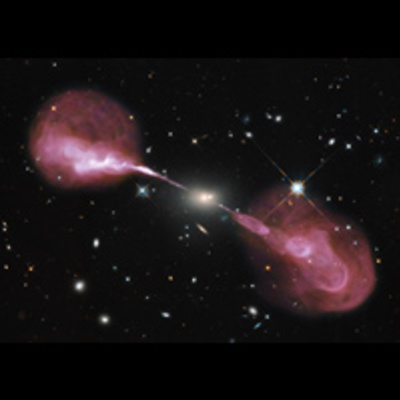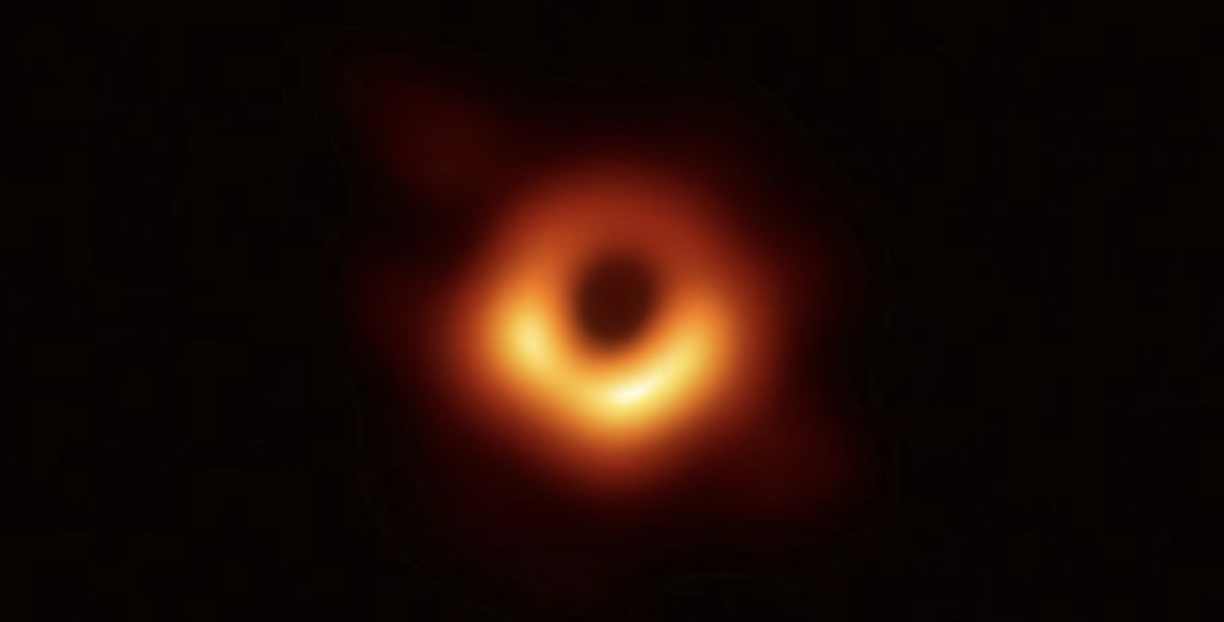Research
Black Hole Astrophysics

Image of powerful radio jets First image of a black hole
Evidence that black holes are needed to explain observations began to emerge in the
second half of the 20th century, first with quasars, then X-ray binaries. By the end
of the century, the Hubble Space Telescope provided strong evidence for the existence
of supermassive black holes at the center of all nearby massive galaxies, and two
decades later, the Event Horizon Telescope took the first two pictures of such black
holes in our galaxy, and in M87, 54 million light years away. Galaxies and their black
holes appear to know about each other via the so-called black hole scaling relations,
which are observations relating various properties of a galaxy to the mass of the
supermassive black hole at the galaxy center. Understanding these correlations promises
to reveal the details of how galaxies form and how black holes participate in that
process, including the limits on star formation and galaxy size. Garofalo and colleagues
have produced a paradigm for understanding astrophysical black holes across space
and time that has recently begun to explain these surprising correlations. At its
heart, the paradigm introduces the key concept of counter-rotating black holes, which
provides the thread for understanding the observations across the mass scale, throughout
the cosmos, and all the way back in time to the formation of the first quasars 13
billion years ago.
A merger leads to a radiatively efficient disk (yellow) counter-rotating about a high
spinning black hole. Because the inner edge of the disk is further away from the black
hole in such a configuration, the jet is not suppressed, which creates a low density
funnel-like region by pushing gas into a higher density region and enhances star formation
(white). Because counter-rotation spins the black hole down, the jet turns off and
the Bardeen-Petterson effect disappears. This leads to a tilt in the accretion disk,
which evolves into a hot advection dominated flow (green). When the spin is sufficiently
high in corotation, a new jet is formed which is entrained in the denser ISM and an
FRI jet is formed which enhances stellar velocities in the bulge and shuts down star
formation (red). This jet reorientation is the key to understanding feedback from
the most powerful radio galaxies. Video designed by Michael Williams, a physics major at Kennesaw State University.
In the news:
Publications
2025
- Jackson Frangos, Erick Rosen, Michael Williams, Chandra B. Singh, and David Garofalo, How a Klein-Nishina modified Eddington-limited accretion explains rapid black hole growth in the early universe, The Astrophysical Journal, article link
- David Garofalo, Brent McDaniel & Max North, Why jet power and star formation are uncorrelated in active galaxies, Galaxies, article link
- David Garofalo, Jets from powerful black holes can point astronomers toward where - and where not - to look for life in the universe, The Conversation, article link
2024
- Chandra B. Singh, Michael Williams, David Garofalo, Luis Rojas Castillo, Landon Taylor, Eddie Harmon, Characteristics of powerful radio galaxies, Universe, article link
- David Garofalo, Chandra B. Singh, Eddie Harmon, Michael Williams, Luis Rojas Castillo, The properties of FR0 radio galaxies as intermediate objects in the evolution of radio galaxies, Journal of High Energy Astrophysics, article link
2023
- David Garofalo, Damian J. Christian, Chase Hames, Max North, Keegan Thottam, Samuel Nazaroff, Alisaie Eckelbarger, M-σ relations across cosmic time, The Open Journal of Astrophysics, article link
- Chandra B. Singh & David Garofalo, The massive black holes, high accretion rates, and non-tilted jet feedback, of jetted AGN triggered by secular processes, Journal of High Energy Astrophysics, article link
- David Garofalo, The Past and Present of the Cosmos, Routledge, publication link
- David Garofalo, Advanced life peaked billions of years ago according to black holes, Galaxies, article link
- David Garofalo, Counter-rotating black holes from FRII lifetimes, Frontiers in Astronomy and Space Sciences, article link
2022
- David Garofalo, Emily Moravec, Duccio Macconi, Chandra B. Singh, Is jet-reorientation the elusive trigger for star formation suppression in radio galaxies?, Publications of the Astronomical Society of the Pacific, article link
- David Garofalo & Ektoras Pouliasis, Peculiar black hole accretion rates in AGN with highest star formation rates in the universe, Publications of the Astronomical Society of the Pacific, article link
- David Garofalo & Chandra B. Singh, The unusual active galaxy H1821+643 and the elusive nature of FRI quasars, Publications of the Astronomical Society of the Pacific, article link
- David Garofalo & George Mountrichas, The distribution of radio quiet active galactic nuclei in the star formation rate - stellar mass plane, Publications of the Astronomical Society of the Pacific, article link
- David Garofalo, The origin and evolution of giant radio galaxies, Frontiers in Astronomy and Space Sciences, article link
2021
- Chandra B. Singh, Santanu Mondal & David Garofalo, Low frequency quasi periodic oscillations and shocks in accretion onto black hole, Monthly Notices of the Royal Astronomical Society, article link
- David Garofalo & Chandra B. Singh, The astrophysics of rotational energy extraction from a black hole, Nature Astronomy, article link
- Chandra B. Singh, Nelitha Kulasiri, Max North, David Garofalo, The black hole-star formation connection over cosmic time, Publications of the Astronomical Society of the Pacific, article link
- Chandra B. Singh, David Garofalo & Benjamin Lang, Powerful jets from radiatively efficient disks, a decades-old unresolved problem in high energy astrophysics, Galaxies, article link
2020
- David Garofalo & Chandra B. Singh, The emergence of the X-ray luminosity/cluster richness relation for radio galaxies, The Astrophysical Journal, article link
- David Garofalo & Katie Bishop, Evidence for radio loud to radio quiet evolution from red and blue quasars, Publications of the Astronomical Society of the Pacific, article link
- David Garofalo, Brandt Webster, Katie Bishop, Merger signatures in radio loud and radio quiet quasars, Acta Astronomica, article link
- David Garofalo, Spin of the M87 black hole, Annalen der Physik, article link
- David Garofalo, Max North, Leanne Belga, Kenzi Waddell, Why radio quiet quasars are preferred over radio loud quasars regardless of environment and redshift, The Astrophysical Journal, article link
- David Garofalo, Ravi Joshi, Xiaolong Yang, Chandra B. Singh, Max North, Matthew Hopkins, A unified framework for X-shaped radio galaxies, The Astrophysical Journal, article link
2019
- Chandra B. Singh, David Garofalo, Kathryn Kennedy, The generalized Hardness-Intensity diagram for black hole and neutron star X-ray binaries, The Astrophysical Journal, article link
- David Garofalo, Merger signatures in low excitation radio galaxies, Monthly Notices of the Royal Astronomical Society, article link
- David Garofalo, Damian J. Christian, Andrew M. Jones, The sub-Eddington boundary for the quasar mass-luminosity plane: A theoretical perspective, Universe, article link
- David Garofalo, Resolving the radio loud/radio quiet dichotomy without thick disks, the Astrophysical Journal Letters, article link
- David Garofalo & Chandra B. Singh, FR0 radio galaxies and their place in the radio morphology classification, the Astrophysical Journal, article link
- David Garofalo, Chandra B. Singh, Dylan T. Walsh, Damian J. Christian, Andrew M. Jones, Alexa Zack, Brandt Webster, Matthew I. Kim, The redshift distribution of BL Lacs and FSRQs, Research in Astronomy and Astrophysics, article link
2018
- David Garofalo, Chandra B. Singh, Alexa Zack, The distribution and lifetime of powerful radio galaxies as a function of environment and redshift, Scientific Reports - Nature, article link
- Chandra B. Singh, David Garofalo, Elisabete M. de Gouveia Dal Pino, Magnetic reconnection and Blandford-Znajek process around rotating black holes, Monthly Notices of the Royal Astronomical Society, 2018 article link
2017
- David Garofalo, Magnetic fields threading black holes: Restrictions from general relativity and implications for astrophysical black holes, Astrophysics & Space Science, 2017 article link
2016
- Matthew I. Kim, Damian J. Christian, David Garofalo, Jaclyn D'Avanzo, Possible evolution of supermassive black holes from FRI quasars, Monthly Notices of the Royal Astronomical Society, article link
- David Garofalo, Matthew I. Kim, Damian J. Christian, Emily Hollingworth, Aaron Lowery, Matthew Harmon, Reconciling AGN-star formation, the Soltan argument, and Meier's paradox, the Astrophysical Journal, article link
- David Garofalo & Chandra B. Singh, Scale-invariant jet suppression across the black hole mass scale, Astrophysics & Space Science, article link
2015
- David Garofalo, Symmetry and the arrow of time in theoretical black hole astrophysics, Journal of Gravity, article link
2014
- David Garofalo, Matthew I. Kim, & Damian J. Christian, Constraints on the radio loud/radio quiet dichotomy from the fundamental plane, Monthly Notices of the Royal Astronomical Society, article link
2013
- David Garofalo, The jet-disc connection: evidence for a reinterpretation in radio loud and radio quiet active galactic nuclei, Monthly Notices of the Royal Astronomical Society, 2013 article link
- David Garofalo, Retrograde versus Prograde Models of Accreting Black Holes, Advances in Astronomy, article link
2011
- Masanori Nakamura, David L. Meier & David Garofalo, Magnetohydrodynamic properties of extragalactic jets, Astrophysics & Space Science
2010
- Masanori Nakamura, David Garofalo & David L. Meier, A magnetohydrodynamic model of the M87 jet. I. Superluminal Knot Ejections from HST-1 as Trails of Quad Relativistic MHD Shocks, the Astrophysical Journal, article link
- David Garofalo & David L. Meier, Misconceptions about general relativity in theoretical black hole astrophysics, Monthly Notices of the Royal Astronomical Society, article link
- David Garofalo, Daniel A. Evans & Rita M. Sambruna, The evolution of radio loud active galactic nuclei as a function of black hole spin, Monthly Notices of the Royal Astronomical Society, article link
2009
- David Garofalo, Signatures of black hole spin in galaxy evolution, the Astrophysical Journal Letters, 2009, article link
- David Garofalo, The spin dependence of the Blandford-Znajek effect, the Astrophysical Journal, 2009, article link
- David Garofalo, Spacetime constraints on accreting black holes, Physical Review D, 2009 article link
2008
- David Garofalo, Magnetic fields around black holes, PhDT, link
2006
- Chris Reynolds, David Garofalo & Mitch Begelman, Trapping of magnetic flux by the plunge region of a black hole accretion disk, the Astrophysical Journal, article link
2005
- Chris Reynolds, Laura W. Brenneman & David Garofalo, Black hole spin in AGN and GBHCs, Astrophysics & Space Science
- David Garofalo & Chris Reynolds, Sporadically torqued accretion disks around black holes, the Astrophysical Journal, article link
Student researchers (former and current)
- Jackson Frangos
- Erik Rosen
- Landon Taylor
- Michael Williams
- Luis Rojas Castillo
- Eddie Harmon
- Keegan Thottam
- Chase Hames
- Alisaie Eckelbarger
- Duccio Macconi (PhD in astrophysics from the University of Bologna, Italy, 2022)
- Nelitha Kulasiri (Carnegie Mellon University)
- Leanne Belga
- Katie Bishop
- Kathryn Kennedy
- Adam Bunce
- Matthew Hopkins
- Brandt Webster
- Alexa Zack
- Andrew Jones (PhD in Computing with Computational Science & Engineering emphasis at Boise State University 2022)
- Diamonik Hough
- Jordan Simon
- Brenton Raffensberger
- Matthew I. Kim (Former grad student at California State University and Univ. of Manchester, UK)
- Ella Osby (Undergraduate astronomy major at Arizona State University)
- Derrick Pruitt
- Jaclyn D’Avanzo (Graduate student in astrophysics at Clemson University)
- Emily Hollingworth
- Aaron Lowery
- Matthew Harmon
- Michael Barnhill










